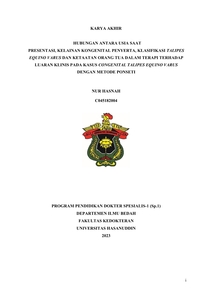HASNAH, NUR (2023) HUBUNGAN ANTARA USIA SAAT PRESENTASI, KELAINAN KONGENITAL PENYERTA, KLASIFIKASI TALIPES EQUINO VARUS DAN KETAATAN ORANG TUA DALAM TERAPI TERHADAP LUARAN KLINIS PADA KASUS CONGENITAL TALIPES EQUINO VARUS DENGAN METODE PONSETI = Factors Influencing Treatment Outcomes of Congenital Talipes Equinovarus Patients Treated with the Ponseti Method. Thesis thesis, Universitas Hasanuddin.
![[thumbnail of Cover]](/47685/1.hassmallThumbnailVersion/C045182004_tesis_28-02-2024%20Cover1.jpg)

C045182004_tesis_28-02-2024 Cover1.jpg
Download (278kB) | Preview
C045182004_tesis_28-02-2024 bab1-2(FILEminimizer).pdf
Download (803kB)
C045182004_tesis_28-02-2024 Dapus(FILEminimizer).pdf
Download (85kB)
C045182004_tesis_28-02-2024(FILEminimizer).pdf
Restricted to Repository staff only until 11 January 2026.
Download (944kB)
Abstract (Abstrak)
The Ponseti method is globally acknowledged as an efficient, widely accessible, and cost-effective approach for managing congenital talipes equinovarus (CTEV), and has been adopted by numerous countries. This study aims to evaluate the factors that may impact the clinical outcomes of CTEV patients treated with ponseti method, including age at presentation, coexisting conditions, classification, and adherence to therapy. A retrospective cohort study design was employed in this observational study. The study population consisted of all CTEV patients who underwent treatment with the ponseti method at Grestelina Hospital, Makassar between 2006 and 2021. Clinical outcomes were assessed using the assessing score treatment score. Statistical analyses included ANOVA and Chi-square tests, with a significance level set of p<0.05. The results show that the study comprises 124 patients. Majority of patients are male (59.7%) and presented within the age range of 0-3 weeks (39.5%), with non-rigid (flexible) type being predominant (84.7%). Most patients have no coexisting conditions (96%) and demonstrate high adherence to treatment (91.9%), resulting in significant clinical improvement (61.3%). The mean age among different clinical outcome groups does not show a significant difference and exhibits heterogeneity (p = 0.072). However, the clinical outcome is significantly associated with CTEV classification (p=0.003) and parental compliance in managing CTEV patients using the ponseti method (p=0.032). In conclusions, the clinical outcomes of CTEV patients treated with the ponseti method are found to be influenced by the classification of CTEV and the level of parental compliance. It is crucial for physicians to encourage guardians and/or parents to adhere to the treatment protocol to increase the likelihood of successful correction.
Keywords: congenital talipes equinovarus, ponseti method, congenital abnormalities, clinical outcome
| Item Type: | Thesis (Thesis) |
|---|---|
| Uncontrolled Keywords: | Congenital talipes equinovarus, ponseti method, congenital abnormalities, clinical outcome |
| Subjects: | R Medicine > RD Surgery |
| Divisions (Program Studi): | Fakultas Kedokteran > PPDS Ilmu Bedah |
| Depositing User: | Rasman |
| Date Deposited: | 22 Jul 2025 01:26 |
| Last Modified: | 22 Jul 2025 01:26 |
| URI: | http://repository.unhas.ac.id:443/id/eprint/47685 |


